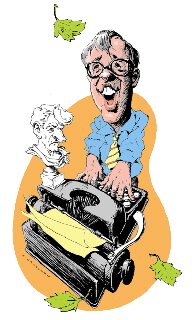Richard Houdek
Long had I admired Alan’s writing style and clear and wise grasp of music, so when, in 1972, in inaugurating plans for an opera symposium as part of San Francisco Opera’s 50th season, I first placed the name Alan Rich at the top of the list of dream participants. I wrote to Alan, relating my admiration for his work in the New York Herald-Tribune, later in New York magazine, and inviting him to travel to the City by the Bay to share his thoughts with others on the present and future of the lyric theater.
Happily, he accepted, joining Bernheimer, Porter and other luminaries of the press who included our local scribes Commanday, Fried, Bloomfield and Von Buchau to help celebrate a season that include three Wagner “Ring” Cycles, “Norma” with Joan Sutherland and the rest of the Sutherland-Bonynge Rat Pack, “Lucia” with Sills and Pavarotti, “L’Africain” boasting Verrett and Domingo who also was our Cavaradossi in the opening “Tosca,” a string of “Aida’s” with myriad debacles and a few triumphs, a “Figaro” glowing with Evans in the title role and colleagues on the cusp of world fame – Te Kanawa, Blegen, Von Stade and Wixell, and finally the American. premiere von Einem’s “Visit of the Old Lady” with that grand dame of the opera stage, Regina Resnick as that lady, in a production staged by Francis Ford Coppola.
Alan was brilliant, as expected and I was thrilled to have him and kept in touch thereafter. A few years later, after I migrated from the public relations department of the opera and landed at California Institute of the Arts in Valencia, near Los Angeles, I found myself involved with a music festival. And since CalArts was thoroughly committed to contemporary arts, I was drawn again to Alan, knowing of his deep interest in the music of our time. This time I called him on the phone, and the invitation was accepted eagerly – the festival was in January when Southern California is temperate, especially compared to the frigidity of New York.
Once there, gleefully surrounded by the au courant efforts of Subotnick, Powell, Cage, Feldman and the others, Alan also took a shine to the rest of the Southland climate. “Ah,” he said, one balmy night over al fresco drinks, this is the way life should be.”
“Well, it’s not impossible,” I replied. “You know, we have this magazine, New West. It’s owned by the same people who have New York, but I don’t believe they’ve discovered the music scene here, or for that matter, music itself. Why, you could be the first bi-coastal critic.”
Alan gave me one of his characteristic long, thoughtful looks, suggesting that it probably was not all that possible, but inwardly suspecting, hoping, otherwise. And indeed, the publishing business was more expansive in those days – it was 1977 – and budgets were more adventurous and flexible.
Sooner than expected, Alan was one of those jet-setters, much like many of the conductors and other musical artists he was covering, and Los Angeles inaugurated one of its great critical eras – Bernheimer on one side of town, Rich on the other, to match the flexing of its artistic muscles with a succession of stimulating conductors on the Philharmonic podium, the eventual emergence of the fourth largest opera company in America and a concert hall that became the envy of the nation. Through CalArts’ REDCAT downtown, the late Betty Freeman’s salons, a major effort by Esa Pekka Salonen, Ernest Fleischman and the Philharmonic and other platforms, the city became a major bastion of 20th- and 21st-century music to, mirroring its esteemed reputation in contemporary art.
After we left L.A., in 1980, My wife, Peggy, and I greeted Alan, once more in 1989 at our inn, Walker House in Lenox, Mass., where Alan, in addition to marking his 65th birthday with us, displayed his new laptop computer and relished several visits to Tanglewood – of course, to the Festival of Contemporary Music. The post-concert sessions in our parlor, and the breakfast discussions, were memorable to our guests, as well as to us, as Alan placed the music, the composers and the players in perspective. Nevertheless, after the excitement of Tanglewood, Alan was looking forward to returning to Los Angeles, where so much, he believed, was happening, and yet to happen.
Joyfully, Alan Rich was witness to the maturation of a great city of the arts on the move, and will be remembered as part of its greatness.

